Prophylaxis and other medical advancements have helped make it possible for people with bleeding disorders to lead full, active lives. But if you have a bleeding disorder, you do need to put some extra thought and planning into what recreational activities and sports you pursue.
Thankfully, the National Hemophilia Foundation’s (NHF’s) revised Playing It Safe: Bleeding Disorders, Sports and Exercise guide is here to help. Along with key questions and topics to
discuss with your or your child’s care team, the guide’s Physical Activity Ratings provide details of the benefits and risks of no fewer than 82 sports and activities—everything from archery
to Zumba®—plus ways to make them less risky. Activities are rated from 1 (low risk) to 3 (high risk), although many fall within a range, depending on how the sport or activity is performed.
New data on sports and activities for kids with bleeding disorders
The activity ratings form the heart of the guide, and a wealth of data has been published on sports and exercise injury risks since the last edition of Playing It Safe in 2005.
That evidence resulted in some changes to ratings. Fans of indoor rock climbing and indoor or outdoor ropes and challenge courses, rejoice! The risk of those activities was downgraded. “If you’re doing these things safely, with instructors and all the safety equipment and it’s well supervised, then it can actually be a really safe activity. The previous data didn’t state that,” says physical therapist Angela Forsyth, PT, DPT, co-author of the current and previous Playing It Safe editions. She and co-author Alice Anderson, PT, DPT, PCS, were happy about the change because climbing and challenge courses are popular camp activities. Now kids (and adults) can feel safer taking part.
An addition to the ratings that kids probably won’t be happy about is inflatable bounce houses, which are a 2.5 to 3, the same risk level as hockey. The rating simply reflects the data, Anderson stresses. Still, she’s aware that kids will go in bounce houses regardless of the Playing It Safe rating, which is why the guide provides suggestions to make jumping around in them less risky, such as removing footwear, eyeglasses and jewelry, and grouping children together by size and not only age.
Lowering risk
The suggestions to minimize the risk of all the included sports and activities are new to the Playing It Safe guide. “We tried to give more information so people can decide to do something more safely at one level versus another level,” Forsyth says. For example, basketball is rated 1.5 to 2.5, depending on whether a person takes part in a casual game with limited contact or a more intense and competitive one.
Anderson and Forsyth stress that people should consider more than just the ratings numbers when deciding to do a sport or an activity. “Each person presents with an individual body and individual strengths and challenge areas,” says Anderson. Anderson says adults and kids should consult their healthcare team regarding their physical limitations. A physical therapist, for instance, can evaluate strength and flexibility and then provide exercises to help better prepare you for your activities.
In the end, it’s about making informed choices. “We don’t want people just following recipes or seeing an infomercial on TV or just following the crowd as to what’s popular,” Forsyth says. “We want them to really think. Because many exercises and sports can be really good for you and your health, but we don’t want good things to cause an injury or a bleed.”
Learn More
• Download the Playing It Safe guide
• Check out Steps for Living physical activity resources
[Download - Hemophilia Exercise: Do's and Don'ts of Exercise with Bleeding Disorders]


